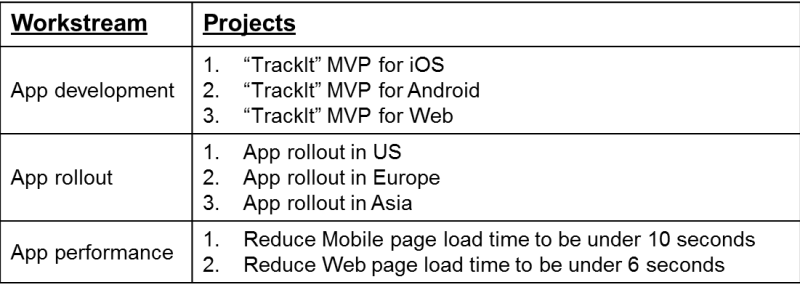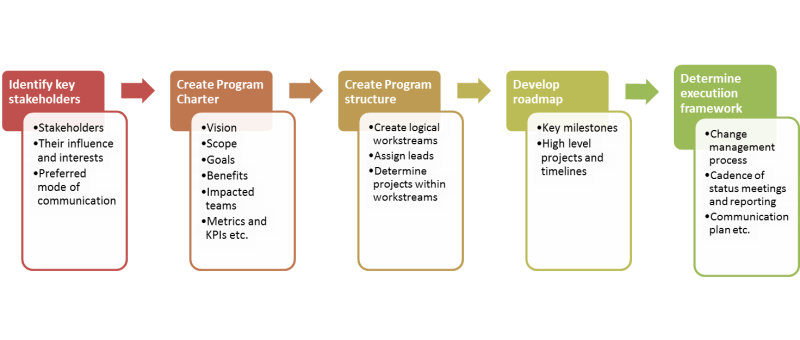5 key steps for setting up a new Program
Starting a new program is both exciting and challenging at the same time. There is a lot of uncertainity and as a TPM it is our job to bring clarity and set up the program for success. In this blog am going to list the five most important steps that are needed to set up a new program. Assumption is that you already have an approved business case and you have been asked to be the TPM for this new program.
While the title says “5 key steps for a new program”, they are applicable for a project as well, with minor caveats. Several people use program and project interchangeably however, they are different. Program scope is much broader and a program consists of multiple projects and/or sub-programs. Will start off with the definition of a program and a project so that it is clear.
Per The Standard for Program Management—Fourth edition (2017) “A program is defined as related projects, subsidiary programs and program activities managed in a coordinated manner to obtain benefits not available from managing them individually.”
Per PMBOK® Guide – Sixth Edition (2017). “A Project is a temporary endeavor undertaken to create a unique product, service or result.”
Example: You are working on a product called “TrackIt” that would track hours spent by a user in learning a new hobby. This app is planned to be available on iPhone, Android, Web in multiple languages and deployed in ~ 50 different countries in a span of ~2 years. You can set up a program structure to develop this product. This program could be broken down into multiple projects: Example:
- Create an MVP (minimum viable product) of “TrackIt” iPhone app within 3 months and launch it in US.
- Gather user feedback and make improvements to the app and release it in all platforms (iOS, Android, Web) in US. Timeline 6 months.
- Deploy the app in Asia etc.
Here are the key things you would need to think about while setting up a new Program.
1. Identify key stakeholders: Identify and list the key stakeholders that have an impact on, or impacted by the program. This list should include the following information:
- Stakeholder Name
- Role
- Program goals they are interested in and are impacted by
- Preferred mode of communication and the aspects they want to be looped in (like risks, change in goals etc.)
Why is this the first step? It is important to list all the key stakeholders as you need their inputs to determine the program vision, goals etc. You might identify new stakeholders along the way and you might have to adjust the roadmap based on their inputs but you need to start off with an initial list. Ex: Sponsor, Product Manager, Engineering lead, Testing lead, Architect etc.
This step is the same for both program and a project.
2. Create the program charter: Purpose of program charter is to align all the stakeholders and involved team members on the key aspects of the program, which are:
- Vision
- Strategic alignment
- Scope
- Goals and non goals
- Metrics and KPIs (key performance indicators)
- Benefits
- High level timelines & milestones
- Impacted teams / resources
- Risks and issues
This step is applicable both for a program and a project. You create a project charter for a project. If the project is part of a program, you don’t need to define the vision as you are doing the project to realize program’s vision. Apart from vision, all the other aspects listed above are applicable.
TPM needs to drive the creation of the program/project charter by involving the key personnel ex: Sponsor, key stakeholders, Product Manager/Owner, technical lead, architect, business analyst etc. This step takes time and analysis.
3. Create program structure: Once you have the program charter, identify the various workstreams (also referred to as pillars/tracks etc.). This is a breakdown of program work into logical groups so that it would be easier to manage. Workstreams is optional but helps with organizing the program better. Determine the projects within each of the workstreams. Example: TrackIt program could have the following workstreams and projects:

If it is for a new project, this step is optional. If it is a big project, then it would be worthwhile to create workstreams for a project as well.
4. Develop program roadmap: Once you have identified the workstreams and goals for each of them, define the steps/milestones to achieve those goals. Use your preferred tool to visualize the roadmap so that it would be easier to communicate to the team. You can use any tool like Smartsheet, MS Project, Excel etc. My absolute favorite tool for creating roadmaps has been “Office Timeline”.
This step is the same for both program and a project.
5. Determine program execution framework: Determine how you are going to execute the program. Some of the key aspects to think through:
- Change management strategy
- Communications plan to include status meetings, reporting cadence etc.
- Escalation/Resolution process
- Testing strategy
- Go-to market strategy
- Metrics and KPIs tracking
- Financial management
- Development methodology (Agile or Traditional/Waterfall or Hybrid)
- Team motivation – how to encourage and sustain team motivation
- Document repository – determine where all the program related artifacts are stored. Ex: wiki, gdrive etc.
This step is applicable for both a program and a project.
These are the 5 keys steps and some steps are more involved than the others. Once you have worked through these 5 steps, set up a program/project kick off meeting and walk through the various aspects in the kickoff meeting. Gather team feedback and make appropriate changes as needed.
Throughout the program execution, evaluate if the program structure and execution framework is working out or not and make changes as needed. You might have to revisit the benefits, goals, workstreams or cadence of the meetings etc. It is important to continue to monitor various aspects of the program on a regular basis and make changes as needed.
Summary:
Here is a high level summary of the 5 key steps involved in setting up a new program. If you join an existing program, it would be good to review that relevant artifacts for each of these steps exist and if they do not exist, would be a good idea to go through the effort to create the required artifact.

I was wondering if you ever considered changing the layout of your blog?
Its very well written; I love what youve got to say.
But maybe you could a little more in the way of content so people could connect
with it better. Youve got an awful lot of text for only having one or two pictures.
Maybe you could space it out better?
Thank you for the feedback. I will keep this in mind for my subsequent blogs.
This is great Sree. I love it!